The Mining Process
An overview for students
The mining process in Waihi, from beginning to end, can be described under these headings:
- Find it
- Dig it
- Crush it
- Treat it
- Manage the waste
- Make the water clean as clean
- Make it all green again.
1. Find it
Exploring, investigating, baseline monitoring, permitting.
The first part of the mining process involves finding the minerals. Exploration for gold and silver for modern mining in Waihi began in the 1970s and prospecting continued into the 1980s.
Diamond-tipped drills bored into the ground and collected core samples from various depths. Around 13,000 metres of drilling was completed and the deepest drill hole was about 450 metres deep.
The core samples were assayed (tested) to determine the mineral content. The assays showed that the samples contained enough gold to make it worthwhile to go ahead with planning to set up a mining operation.
Research of a different sort followed; investigation and monitoring was carried out to assess potential environmental and social effects of a mining operation on the town of Waihi and the surrounding area. Information was gathered over several years before mining licence and water rights applications were lodged in 1985 and 1986. The Mining Licence and Water Rights were granted in July 1987.
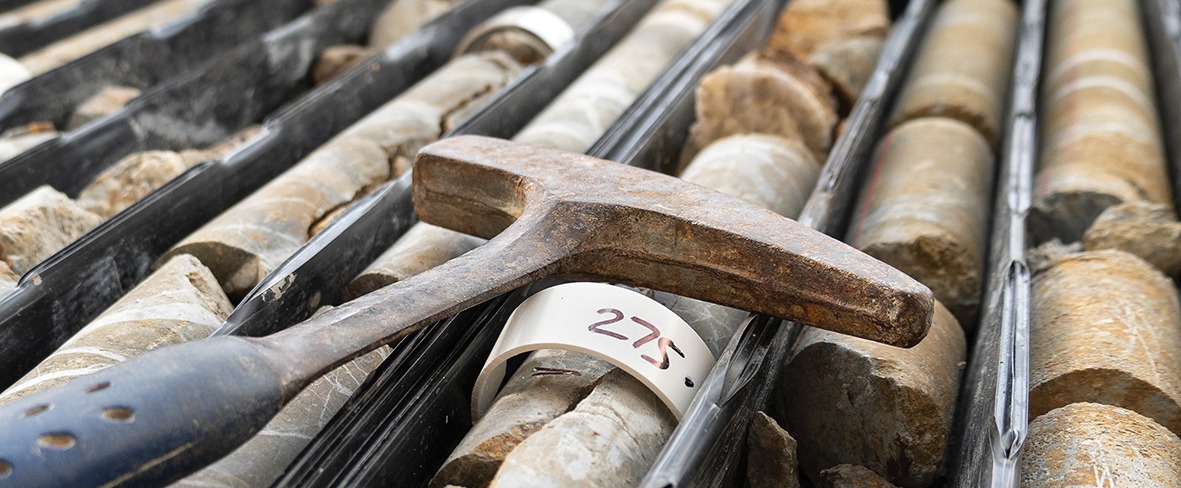
2. Dig it
Sampling, assaying, blasting, mining, dewatering.
Material mined from the open pit or from underground is either ore (containing gold and silver) or waste rock (little or no gold and silver). To find out which is which, samples of rock are collected. The samples are sent to an assay laboratory where the rock is tested for its gold content. Geologists use the results to mark out the sampled areas into zones of ore and waste rock so they can be mined separately.
Areas of hard rock need to be blasted to break it up before it is dug. Then it is excavated by backhoe diggers (open pit) or boggers (underground) and loaded onto trucks.
Each truck used in the Martha Mine open pit can carry about 90 – 100 tonnes of rock. There is approximately $NZ18,000 (based on the gold price in August 2011) worth of gold and silver in a truck-load of ore. The rock is hauled to the primary crushers. The trucks used underground are smaller so they are able to work inside tunnels measuring 5 metres by 5 metres.
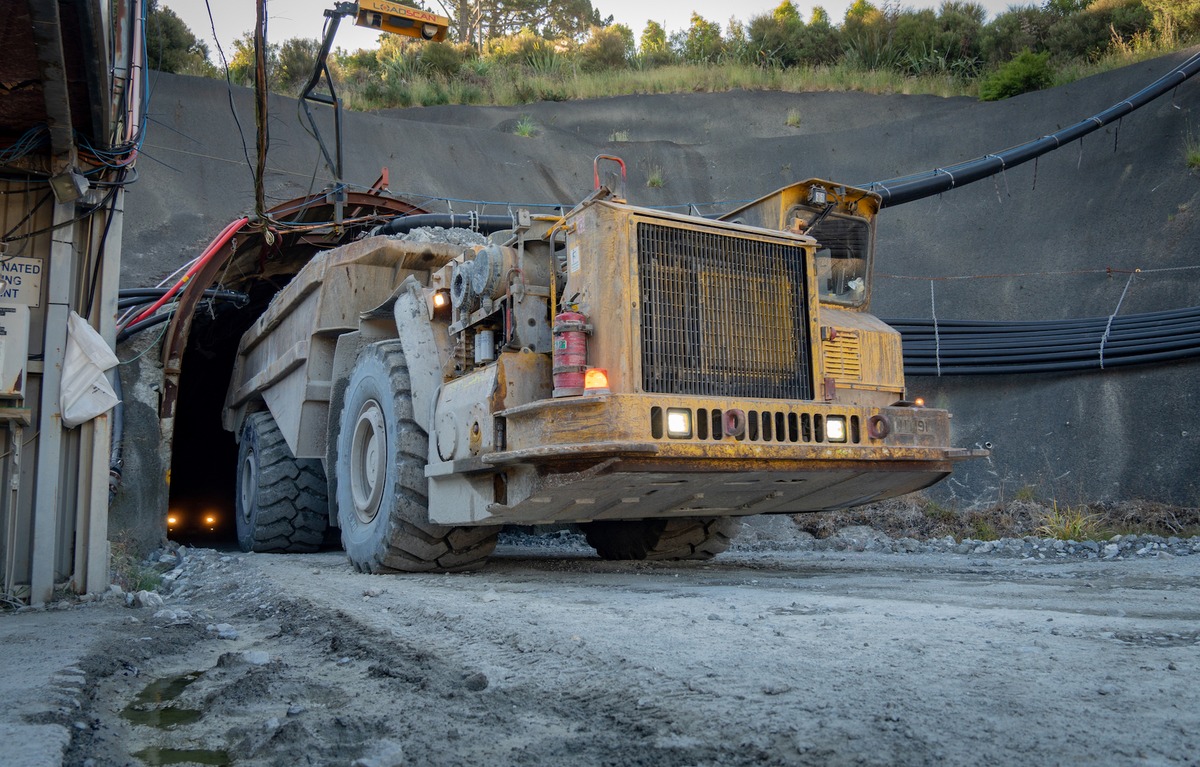
Ground water from around and beneath the open pit is pumped out. Some of this water is used on site to wash vehicles and to spray the haul roads to dampen dust. Excess water is piped over to the water treatment plant near the processing plant to be treated before it is discharged to the Ohinemuri River.
3. Crush it.
Crushing, conveying, stockpiling.
There are two types of crushers used at the Martha Mine site. A jaw crusher breaks up the hardest rock and two feeder breakers deal with the softer material. They break the larger rocks to a size suitable for transport from the mine site.
The rock is carried away from the open pit by a conveyor belt. Ore and waste rock travel on the same conveyor, but at different times of the day. Ore travels 1.7 kilometres to the stockpile at the processing plant. Waste rock travels 2.7 kilometres to the load-out near the waste rock embankments. About 30,000 – 50,000 tonnes of rock is carried on the conveyor belt each 12 hour day. This is enough to cover a whole rugby field to a depth of one metre.
The rock sometimes contains metal and timber from the old workings. This is called tramp material. The metal is picked up by electromagnets and the wood is taken off the conveyor belt by hand.
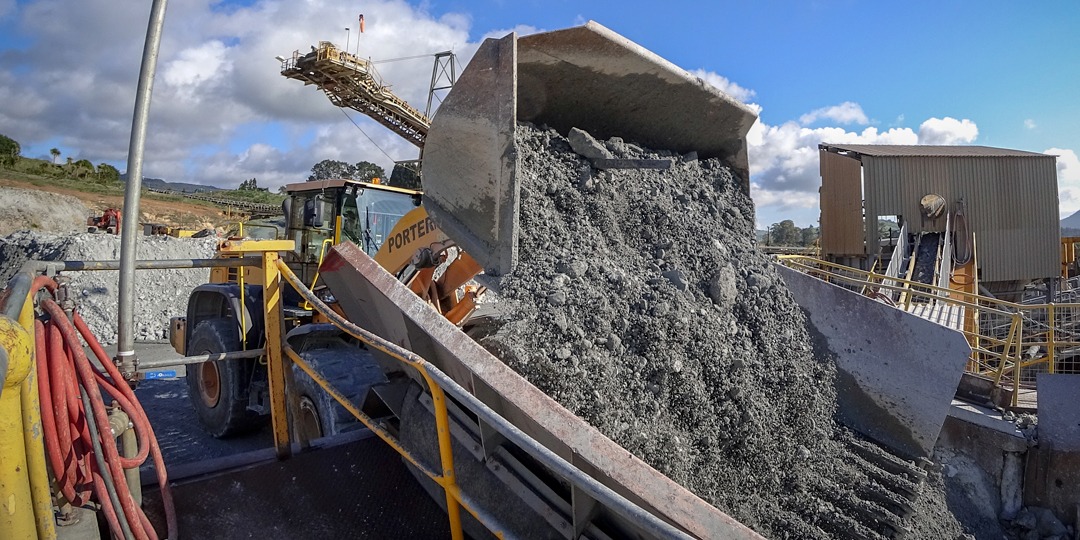
A loader feeding a crusher.
4. Treat it.
Grinding and sizing, leaching and adsorption, elution and electrowinning, smelting and pouring.
Grinding and Sizing
Ore processing is a 24-hour operation. A front-end loader feeds ore from the stockpile near the processing plant into a hopper. The ore falls down onto a conveyor belt and is fed into the SAG mill (semi-autogenous grinding mill) along with water, lime and hardened steel balls.
The SAG mill is a large revolving drum. Rock is ground to a fine powder by the turning of the drum and impact from the hardened steel balls and the rock itself. The hardened steel balls are like athletics shot puts in various sizes. They become quite small after a few weeks of tumbling.
A large sieve separates the oversize material and worn-down steel balls from the finer material. The oversize rock is returned to the SAG mill, worn-down steel balls are removed from the circuit with a magnet and the finely ground material is sent to the hydrocyclones.
The hydrocyclones rapidly spin the ground rock to classify it into sizes. Larger particles are returned to the SAG mill or the second ball mill for further grinding. Material that has been ground small enough is sent through to the leach tanks.
The slurry that remains after grinding is complete has a very fine particle size. The rock has been ground to the size of very fine beach sand (80% of the ore particles are less than 70 microns).
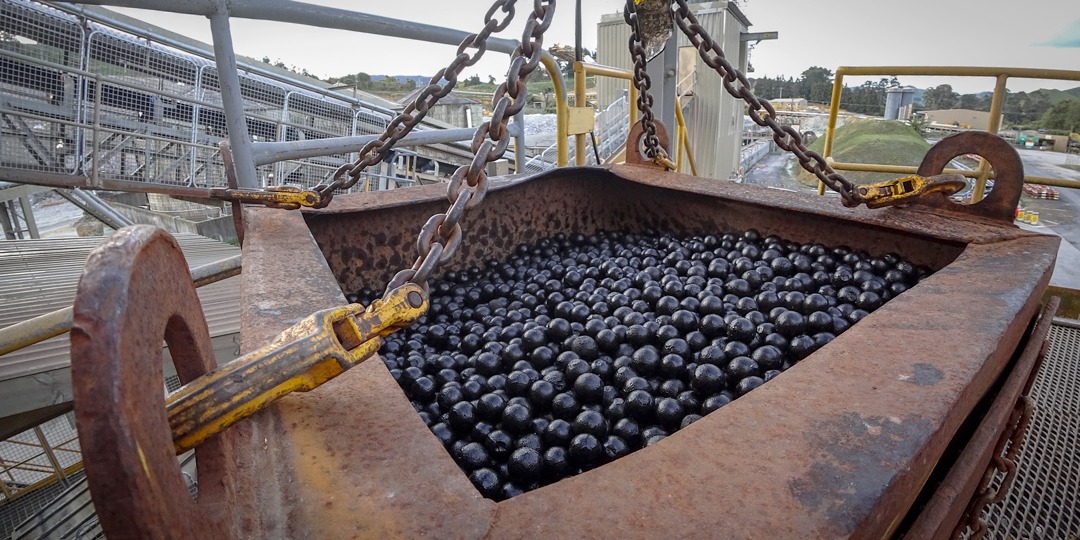
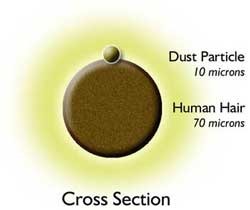
Leaching and Adsorption
The slurry of ground ore, water and lime moves through a series of tanks to which a weak solution of sodium cyanide is added. The gold and silver is dissolved by the cyanide solution, rather like sugar is dissolved by warm water.
The slurry then passes into a series of adsorption tanks. These contain carbon granules. The carbon granules, about the size of chocolate hail and made from coconut shells, have been heated to 600 degrees Celsius. The gold and silver are attracted to the surface of the carbon. This is called adsorption.
The carbon granules, loaded with gold and silver, are removed from the tanks. The barren slurry, now known as tailings, is pumped to the tailings storage area.
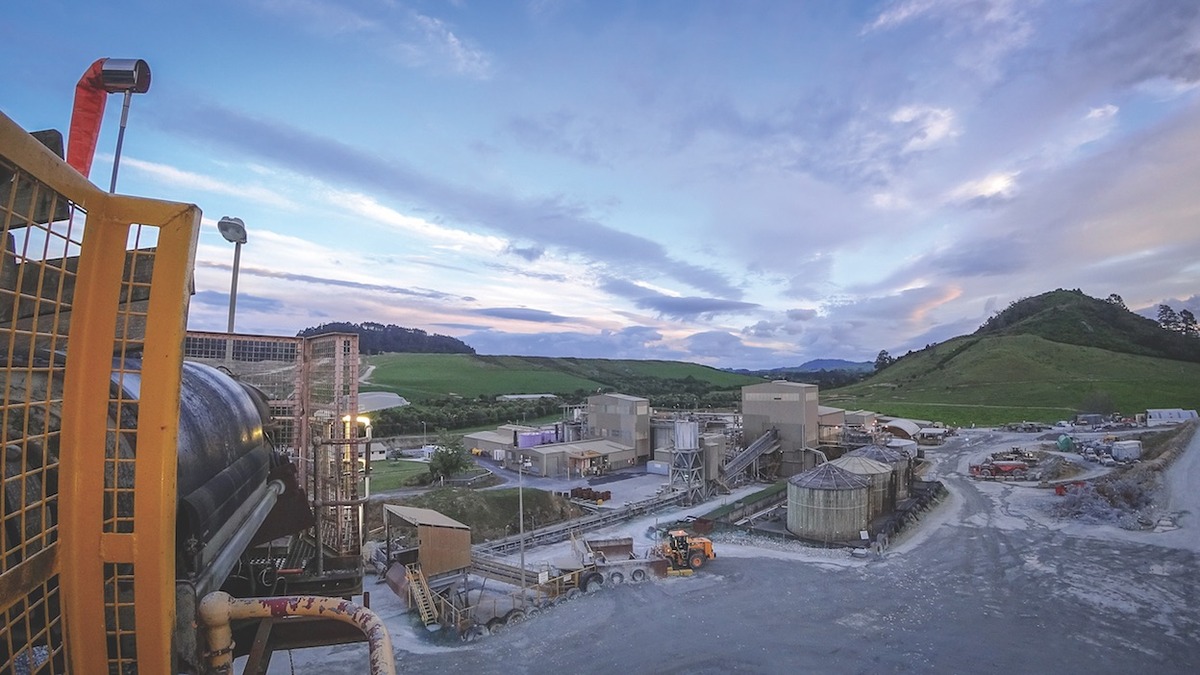
Elution and Electrowinning
After the ‘loaded’ carbon is screened out of the tanks it is pumped to another tank, called an elution column, where gold and silver is washed off the carbon using superheated water. This forms a solution called loaded electrolyte.
The used carbon is washed and reheated to 600 degrees Celsius. This makes it active again. The carbon is returned to the tanks for further adsorption.
The loaded electrolyte solution is passed through a series of electrowinning cells that contain stainless steel plates. A positive charge is sent through the solution. The stainless steel plates are negatively charged (cathodes). Electrowinning causes the gold and silver to deposit onto the stainless steel cathodes.
The cathodes are removed and rinsed to yield a muddy sludge and then reused. The muddy sludge is dried to a powder.
Smelting and Pouring
The powder is mixed with ingredients called fluxes that are designed to form a slag of impurities that can be removed later.
The powder and fluxes are put into the crucible and heated to 1200 degrees Celsius. After several hours the molten material is poured from the crucible into a cascade of moulds to form doré bullion bars. The slag is chipped off the surface, leaving bars which are 99% pure gold and silver. Each bar of doré bullion contains around 75 to 90% silver and 10 to 25% gold and weighs approximately 20 kilograms.
The bullion is sent to the Western Australian Mint in Perth, where it is further refined to separate the gold from the silver. Then it is sent to the international market to be sold.
5. Manage the waste
Tailings, Waste Rock
The two main waste materials that come from the mining operations are tailings and waste rock.
Tailings is the name for the slurry that is left after gold and silver have been extracted from the crushed ore. Tailings slurry is made up of approximately 30% finely crushed solids and 70% water, including small amounts of cyanide that remain after processing the ore.
Because tailings contain cyanide, it is important that they are managed carefully.
Tailings are pumped to the top of the waste rock embankment and placed into a pond. Here, the fine solids settle and compact. The water in the tailings is decanted from the surface of the pond and sent back to the processing plant to be reused in the grinding circuit.
In the tailings pond, cyanide in the water is rapidly broken down by sunlight into naturally-occurring carbon and nitrogen. Any seepage from the tailings pond is collected in an under-drainage system built within and below the embankments.
Waste rock is material from the open pit that doesn’t have enough gold in it to make it worthwhile for processing to extract gold and silver. However, waste rock is very important as building material for the waste rock embankments of the tailings storage areas.
There are several types of waste rock. The various types must be sorted, mined separately and used in the most suitable places within the embankments. For instance, material known as ash is best used as a subsoil beneath topsoil and pasture; some types of rock are easily compacted and are best used as lining material. The diagram below shows the range of zones within the waste rock embankments.
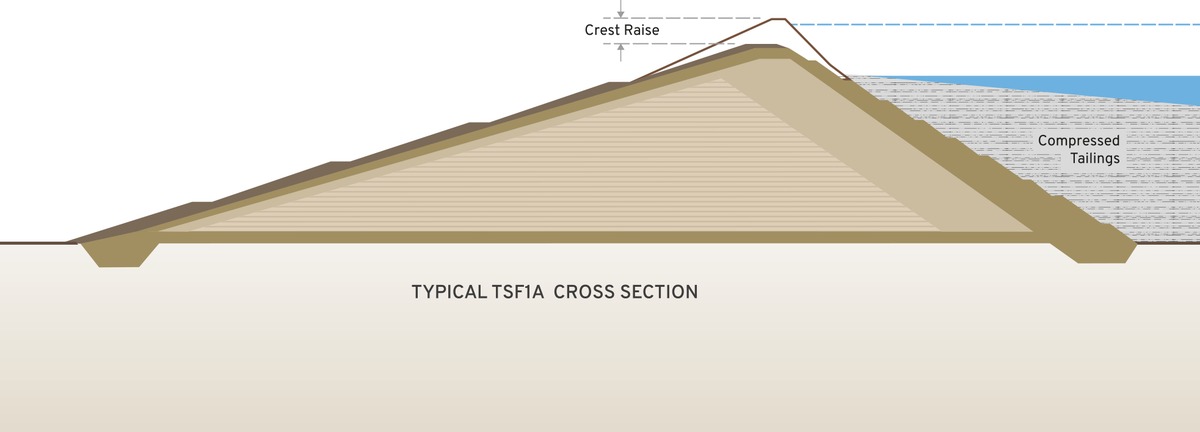
- Zone A: Lining material for the base of the waste rock embankment
- Zone B: Lining material for the upstream shoulder of the embankment
- Zone C: Helps to form a strong layer next to the upstream shoulder
- Zone D: Forms the bulk fill in the embankments
- Zone E: Similar to Zone D
- Zone F: Forms a layer between Zone D and Zone G
- Zone G: Forms a capping layer as a base for rehabilitation
- Zone H: The rehabilitation cover, or subsoil, that lies under the topsoil layer.
6. Make the water clean as clean
Water treatment, chemical analysis and flow monitoring, biological monitoring.
The Waihi area has a high rainfall and this means that there is more water on the mine site than is needed for the mining operation. Water that is not needed on site goes to the Ohinemuri River.
There are strict controls over the quality of water that goes into the river. All water discharged from site must meet strict standards and usually requires treatment at the water treatment plant.
There are four sources of water on the mine site:
- mine water is pumped from underground, beneath the open pit
- stormwater runoff is collected in silt ponds and collection ponds around the site
- decant water is collected from the surface of the tailings ponds
- under-drainage water is collected from drains beneath the tailings ponds and waste rock embankments.
Mine water and stormwater contain metals and trace ions that must be removed or reduced in the water treatment process.
Decant water and under-drainage water contain cyanide that must be removed before being treated in the same way as mine water and stormwater.
The required standards for the quality of water that goes to the river are set in the Resource Consents issued by Waikato Regional Council.
Water treatment, chemical analysis and water flow monitoring
Samples are collected at various stages of the treatment process and sent to independent laboratories for analysis. The standards used for the quality of discharge water are based on the United States Environmental Protection Agency (USEPA) guidelines for the protection of aquatic life (where such appropriate limits exist, and other guidelines where appropriate).
Water flows are also measured. The consents allow up to 20,000 cubic metres per day to be discharged from the water treatment plant, or 15% of the river flow, whichever is the lesser.
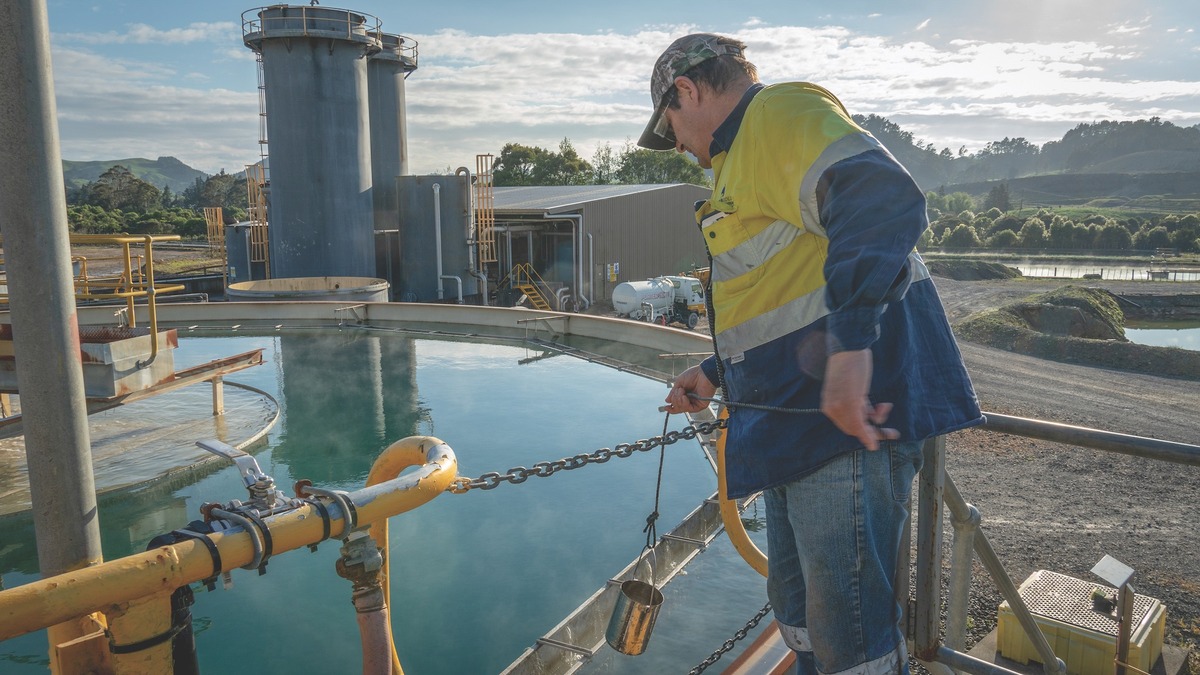
Biological monitoring
Baseline studies of the water quality and aquatic biology of the Ohinemuri River and its tributaries began in 1981. Monitoring is ongoing and is an important part of the treated water discharge consents.
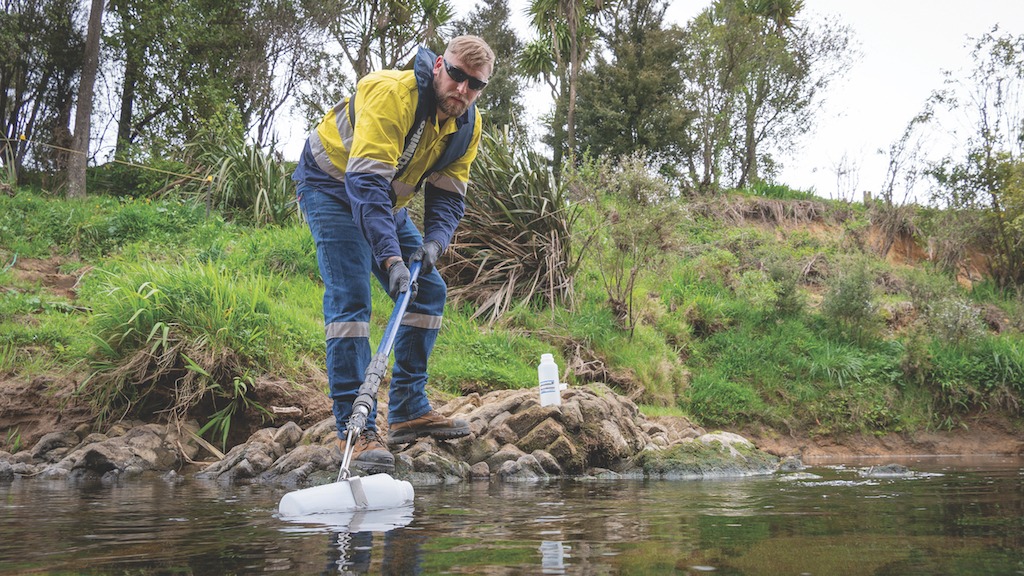
7. Make it all green again
Progressive rehabilitation, open pit, waste rock embankments, other areas, the Martha Trust.
Rehabilitate = renew, restore, convert, fix up, make good, rebuild…
This means planting trees, planting pasture and planning for the future.
Progressive rehabilitation
Some rehabilitation is ongoing while the mine is operating. Whenever activity in an area is complete, progressive rehabilitation takes place, establishing and building towards the long term rehabilitation plans. This can involve contouring final pit walls and waste rock embankments, planting pasture and creating areas of trees and shrubs.
Progressive rehabilitation enables disturbed land to become productive as early as possible. It also provides a vegetation cover over areas where bare earthworks could otherwise cause erosion, dust and silt, as well as appearing unsightly.
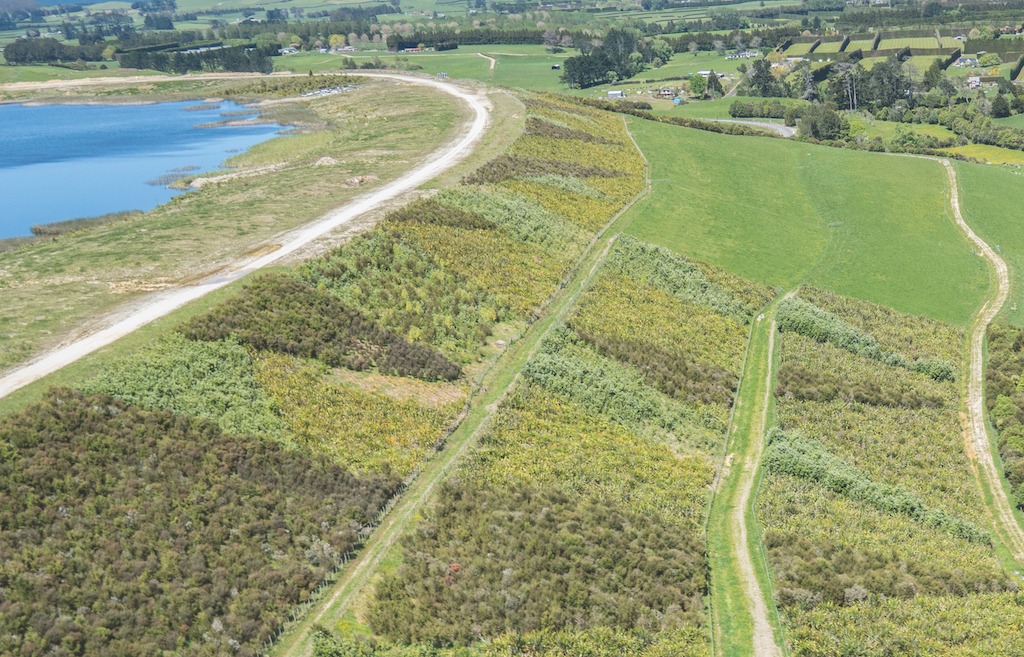
Final rehabilitation of the open pit
Once mining is complete, the open pit will become a recreational lake with adjacent park-lands. The open pit, 250 metres deep, will begin to fill with water when mining is finished and it will take about six years to fill to a depth of 195 metres. The pit walls above the lake level will be planted, where possible, with trees and shrubs. Some areas of the lake will have shallow edges to form a lake shore and there will be recreational areas.
Final rehabilitation of the waste rock embankments
The land at the waste rock embankments will be returned to pasture, with pockets of native trees and shrubs. A wetland area will be created at the top of both embankments with pasture capping around it and a littoral zone of plants such as raupo, flax and cabbage trees between the pasture and the pond edge.
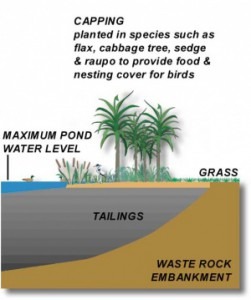
Final rehabilitation of other areas
Along the conveyor path and at the processing plant, buildings, equipment, structures and tanks will be dismantled and removed. The ground will be recontoured, replaced with pasture and planted with trees and shrubs. It is possible that the conveyor path could be developed as a walkway to link up with a network of other walks around the local area.
The water treatment plant is expected to be in continued use for a time after the mine has closed. When it is no longer necessary it will be transferred to the Martha Trust.
The Martha Trust
After mining stops at the Martha Mine, stages known as ‘Closure’ and ‘Post Closure’ begin. Closure is the period of final rehabilitation and finishes when the regulatory authorities consider the site has reached a ‘safe, stable, self-sustaining, rehabilitated state’.
The Post Closure period starts with the formation of the Martha Trust. The Trust will own, manage, monitor and maintain the land and facilities at the wetlands, water treatment plant and the parklands adjacent to the lake. It will also be responsible for maintenance and monitoring of the lake. The Company will hand over a sum of money to the Trust. This money and the interest it earns will be used to carry out the responsibilities of the Trust in perpetuity.
More detail on the mining process can be found in the mining and environment sections of this website.